Country
Profiles
Country
Networks
Country
Associations

Mangrove ecosystems mapping in parts of Ghana and The Gambia for sustainable regeneration and utilization
Abstract
This study was conducted in parts of Ghana and The Gambia using remote sensing and participatory geographic information system (PGIS) to map mangrove vegetation and associated land use land cover types. The selected sites support shellfishery activities, and mangrove loss threatens ecosystem functionality and local communities’ livelihoods. The results revealed that mangroves are more fragmented and declining in Ghana sites, while in The Gambia, they are more extensive and stable, with a clear zonation of Rhizophora and Avicennia species. PGIS revealed that communities value mangrove species differently, informing the management systems. Avicennia species that were more abundant in Ghana sites were mainly used for livelihood activities such as fuelwood and the construction of fish traps. Rhizophora species that were more dominant in The Gambia sites have better oyster attachments due to their root systems and were more valued by the shellfishing communities. Triangulated results from remote sensing and PGIS established various drivers and threats to mangrove vegetation, including mangrove dieback, illegal harvesting, soil salinity, land use changes/conversion, waste dumping/pollution, and the effects of climate change. Lessons for sustainable mangrove area co-management included context-specific interventions based on livelihood needs, continuous community awareness, capacity development for effective mangrove restoration and conservation, and diversification of livelihood options. It is also crucial to develop the enabling environment through policies that strengthen co-management, local and national governance systems, and enforcement of existing policies. The study reiterated the value of integrated resource mapping and results validation with stakeholders who are either users or managers of these resources.
Keywords: Coastal management, Remote sensing, Shellfisheries, Natural resources mapping, Mangroves, Participatory GIS, Land use land cover
on Mar 2025
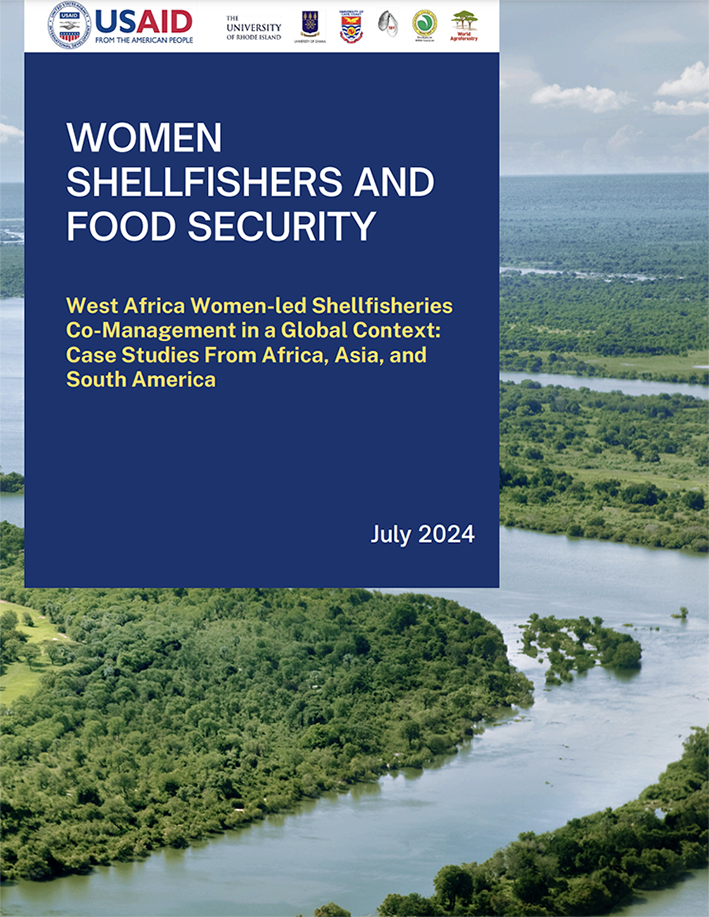
West Africa Women-led Shellfisheries Co-Management in a Global Context: Case Studies From Africa, Asia, and South America
The objective of this desk study is to examine links between West Africa women-led shellfisheries co-management approaches, research and findings and other initiatives that address similar gender-based themes in coastal resource management around the globe in low- and middle-income countries. It highlights cases that explore links between womenled shellfisheries co-management in estuarine mangrove ecosystems and biodiversity conservation, gender equity, climate change adaptation and mitigation, sustainable smallscale fisheries, and food security. The report’s target audience is practitioners involved in promoting the management and conservation of estuarine shellfisheries and habitats for gendered livelihoods support. In addition to The Gambia and Ghana, five cases from the Philippines, Ecuador, Brazil, Kenya, and Tunisia are highlighted with key takeaways for practitioners from each.
on Nov 2024
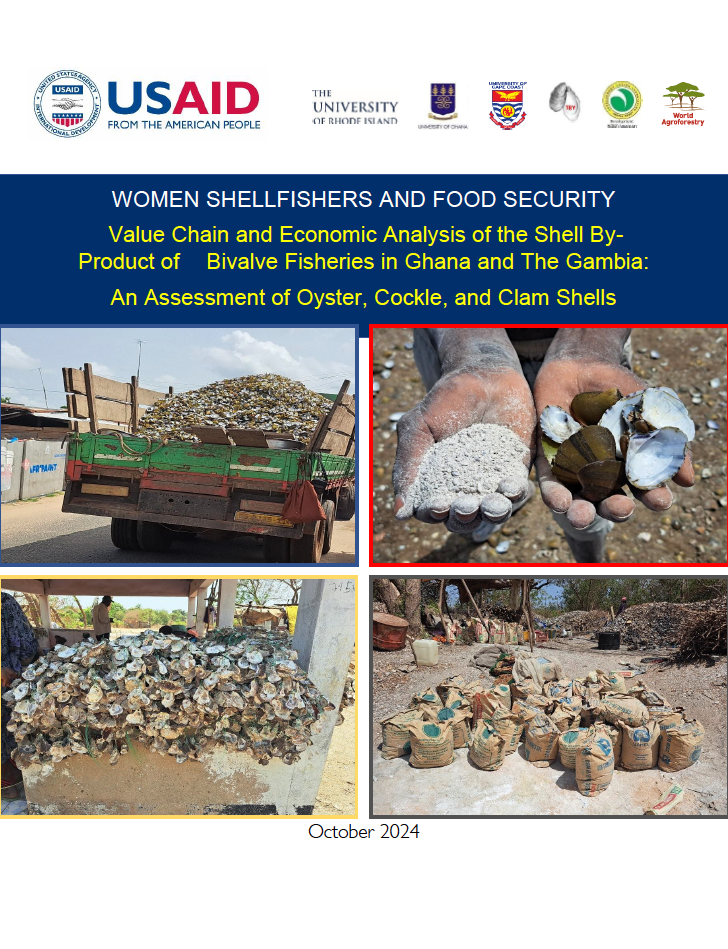
Value Chain and Economic Analysis of the Shell By- Product of Bivalve Fisheries in Ghana and The Gambia: An Assessment of Oyster, Cockle, and Clam Shells
This report examines the shell value chain and the economic potential of shell by-products from bivalve fisheries in Ghana and The Gambia. The study focuses on three key bivalve species: the West African mangrove oyster (Crassostrea tulipa), West African bloody cockle (Senilia senilis), and the Volta clam (Galatea paradoxa). It provides insights into the opportunities and challenges within the shell value chains of these species. Shells were primarily generated as a by-product of shellfish processing and were used for various purposes and products. But the key uses found by this study were milling into granular powder for animal feed formulation; lime production (for use as paint by the construction industry and pond fertilization in aquaculture); domestic use for controlling erosion and land reclamation. The Gambian shellfishers used the oyster shells for oyster culture while the Densu shellfishers used the shells for reef enhancement. Shells were mainly sold, with shells at the peri-urban areas (Densu, Ada, Lamin, and Old Jeshwang) costing about two to three times higher than shells in more rural areas (Narkwa and Kartong). Prices of shells in The Gambia (US$ 0.04-US$ 0.12 per kg) were also about four times higher than in Ghana (US$ 0.01-US$ 0.04 per kg). The study identified five main actors in the bivalve shell value chains across Ghana and The Gambia: shell generators (mainly women shellfish harvesters and a few men shell miners), shell aggregators, semi-finished shell product producers, end-product manufacturers, and end users. Along the milled shell value chain, three channels were observed in the transition of shells from primary producers to end users, with or without intermediaries. Findings indicated that shell processors in Ghana generated more income, especially due to the high demand from the poultry industry.
on Oct 2024
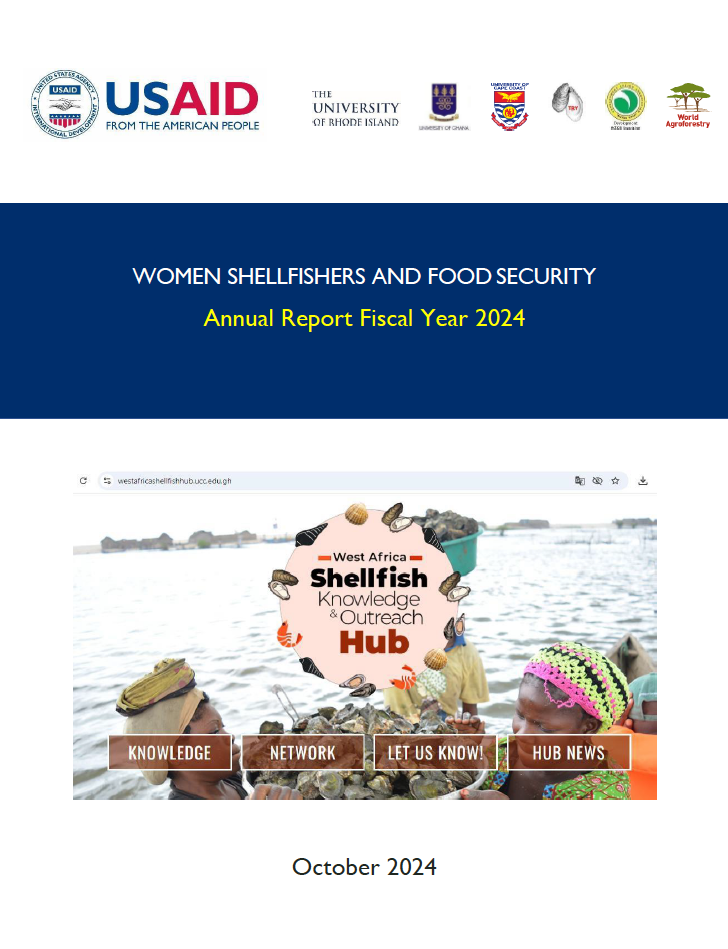
2024 Annual Report: Women Shellfishers and Food Security Project
This report documents progress on Activity implementation at the end of the second year of the three-year extension (FY24), October 2023 – September 2024. (Phase II of the Women Shellfishers and Food Security Project).
on Oct 2024
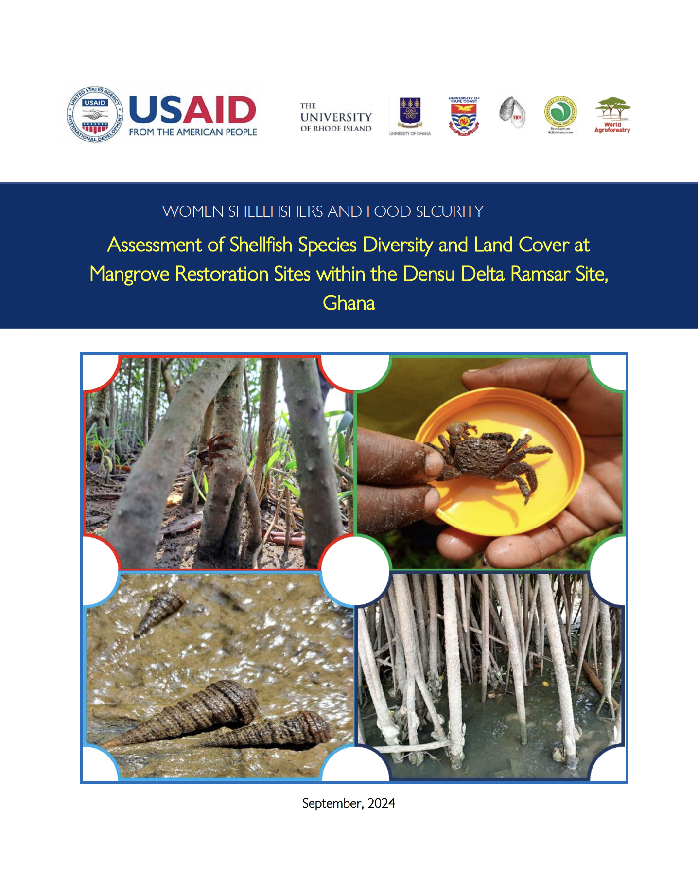
Assessment of Shellfish Species Diversity and Land Cover at Mangrove Restoration Sites within the Densu Delta Ramsar Site, Ghana
This report presents the findings of a baseline study of land cover and shellfish species diversity conducted in January 2024 at two mangrove restoration sites within the Densu Delta; one site (Site 1) replanted in 2017 as part of the USAID/Ghana Sustainable Fisheries Management Project (SFMP) and another site (Site 2) replanted in 2023 through the USAID Women Shellfishers and Food Security project (WSFS). These restoration efforts were aimed at enhancing shellfish production to support the livelihoods of women shellfish harvesters and provide other ecological benefits. The Centre of Coastal Management of the University of Cape Coast conducted the baseline biodiversity assessment using various methods, including land cover surveys, shellfish sampling, and data analysis to establish baselines and inform future assessments of mangrove restoration impacts on shellfisheries biodiversity. Key findings from the land cover survey revealed that Site 1 predominantly consisted of mangrove cover, which accounted for the majority (59.4%) of the land cover in the 18 sampled quadrants. In contrast, Site 2 was dominated by grass cover (45.8%), with significantly less mangrove coverage (3.1%). Results of the current study show that the differences in land cover at the two sites may have considerable bearing on the development and diversity of the shellfish community at each of these sites. Seven shellfish species were encountered at Site 1, whereas Site 2 had four species. The purple mangrove crabs and hermit crabs were observed at Site 1 only. The West African mangrove oysters were found on the roots of the replanted mangroves at Site 1, where they constitute nearly 50% of the shellfish community with the highest mean density of 170 oysters per square meter. The overall higher species diversity and richness at the Site 1 compared to the newly planted Site 2, and the larger mean size of mud creepers at Site 1 compared to Site 2, is a function of time as the mangrove trees at Site 1 planted in 2017 have grown larger thereby providing habitat for expanded biodiversity. These findings highlight the benefits of the Densu Oyster Pickers Association’s (DOPA) mangrove reforestation efforts for improving the Densu Delta’s ecosystem and shellfisheries productivity, which eventually can result in improved food security and livelihood, among others. It is expected that shellfish diversity at Site 2 will also increase with time as the mangrove trees grow larger, and this will be confirmed through future monitoring. Most importantly, these observations provide a baseline for monitoring the development of replanted mangroves and changes in the land cover and shellfish fauna biodiversity over time.
on Sep 2024
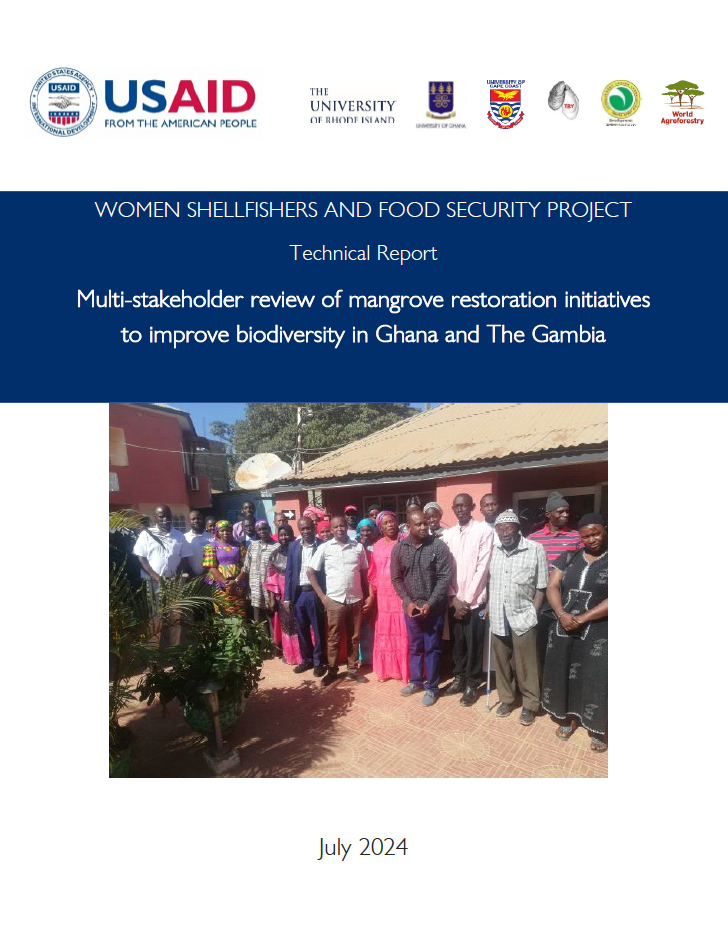
Multi-stakeholder review of mangrove restoration initiatives to improve biodiversity in Ghana and The Gambia
The contribution of stakeholders (resource users, government, NGOs, etc.) towards management of forests through co-management plans for example is crucial in the maintenance of forest resources in the long term. The purpose of this review therefore is to demonstrate the value of multi-stakeholder engagements in local mangrove conservation and restoration initiatives, opportunities, and challenges for improving biodiversity in Ghana and The Gambia to inform policy formulation on mangrove conservation and use.
on Jul 2024

Report on Establishment of Oyster Aquaculture in Lamin, Gambia
TRY Oyster Women’s Association (TRY) piloted oyster aquaculture technologies under past projects, including the USAID/BaNafaa project (2011-2014) and with British High Commission support in subsequent years. These included: floating mesh bags; bamboo racks with suspended strings using empty shells as substrate; and floating bamboo rafts with suspended strings of oyster shells. For this initiative, TRY decided to use a technology that is more durable even though it requires a much more substantial capital investment in materials that are imported. This decision was also based on the deployment of this technology at other sites in The Gambia by the FAO FISH4ACP project and the opportunity for TRY and the Department of Fisheries to develop an understanding and provide technical support for this technology and learning across multiple sites. The technology consists of fixed frames made of iron bars with two levels of plastic mesh bags (top and bottom) attached in a removable manner to the iron frame.
on May 2024
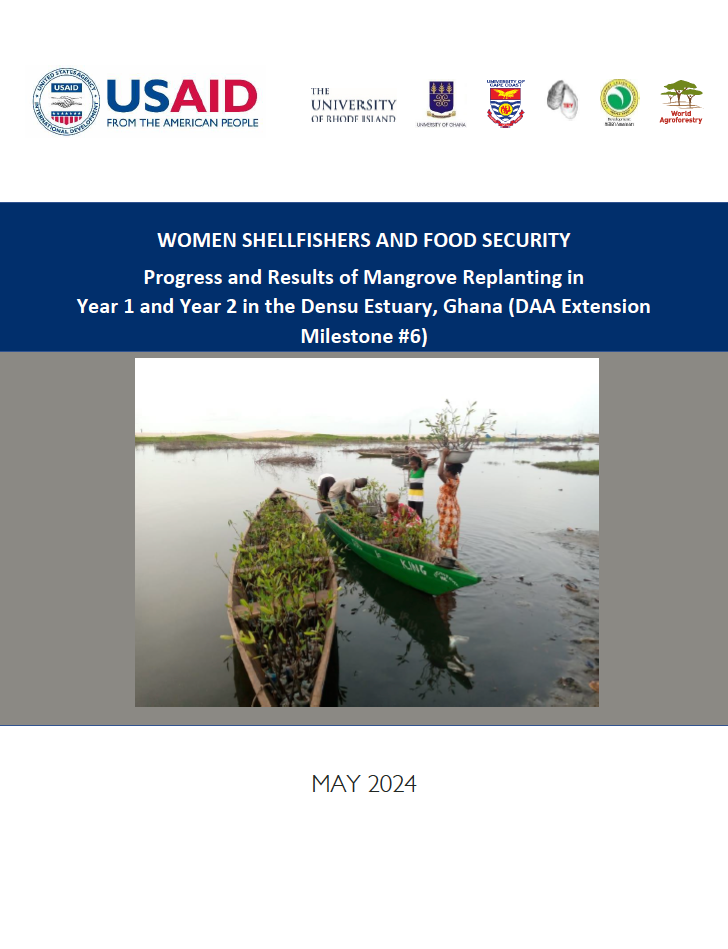
Progress and Results of Mangrove Replanting in Year 1 and Year 2 in the Densu Estuary, Ghana
DAA organized a one-day training for 40 DOPA members (6 men and 34 women) in February 2023 at Tsokomey with a mangrove expert to equip DOPA members with the requisite knowledge and skills on this activity. DAA organized the same training for another 40 DOPA members in December 2023. The trainings took place about the time of the mangrove nursery establishment for each year. The Year 1 nursery was done in February 2023 but that of Year 2 in December 2023 because the Year 2 planting was intended to happen in the early months of 2024 in order to avoid the spilling time of the Weija dam.
on May 2024
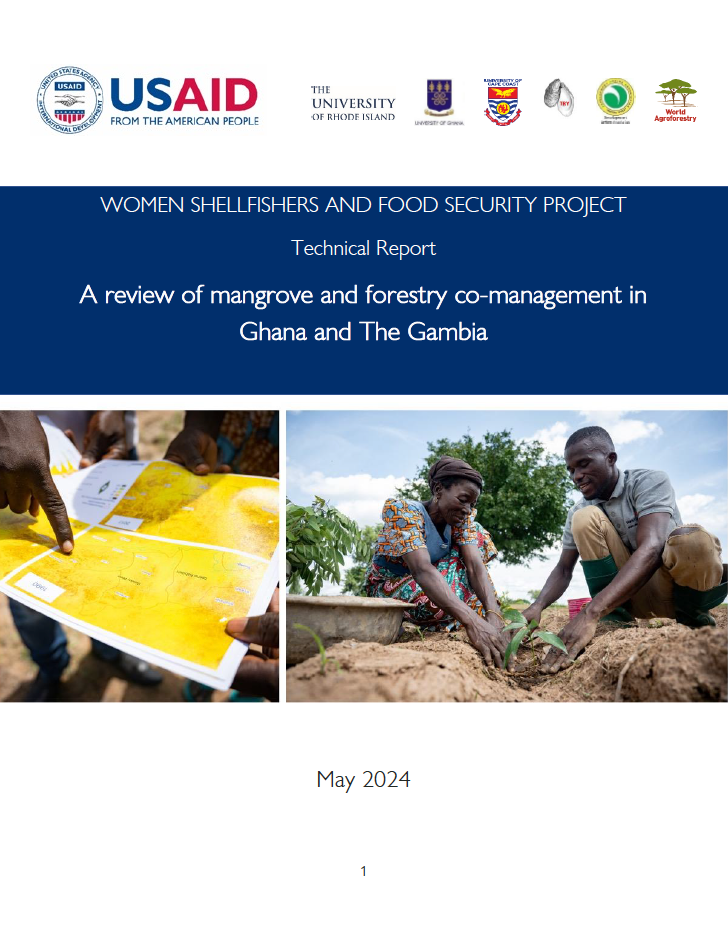
A review of mangrove and forestry co-management in Ghana and The Gambia
This review is part of the USAID supported Women Shellfishers and Food Security Project goal to demonstrate the biodiversity and socio-economic value of more fully integrated rights-based co-management of linked shellfish - mangrove and proximate landscape food ecosystems in Ghana and The Gambia (CRC, 2022). The project goal is to foster the adoption and scaling-up of an integrated approach to conservation and restoration of mangrove and estuarine ecosystems in West Africa that provides cross-sectoral benefits in terms of gender equality and women’s empowerment, economic development, and household food resiliency (USAID, 2022). ICRAF is contributing to the implementation of this objective through a review of mangrove and forestry co-management policies and plans in Ghana and The Gambia. The aim is to identify the existing co-management systems in Ghana and The Gambia to inform decision-making essential for policy formulation on forest conservation and use. This is intended to help inform mangrove co-management at selected project sites documenting past and current mangrove and forest co-management plans and associated efforts, their status, lessons learned, and recommendations.
on May 2024
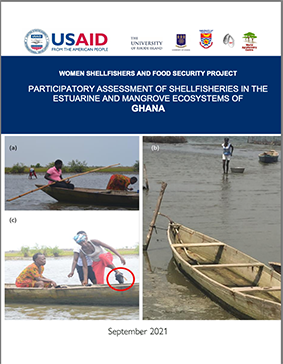
Participatory Assessment of Shellfisheries in the Estuarine and Mangrove Ecosystems of Ghana
on Feb 2024
